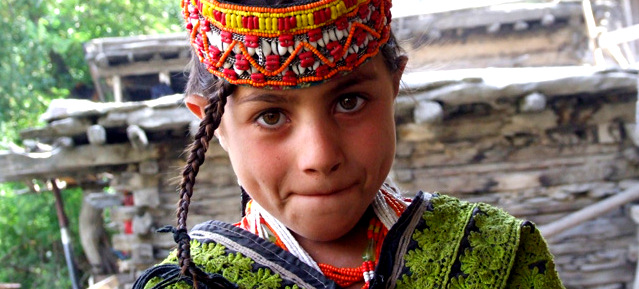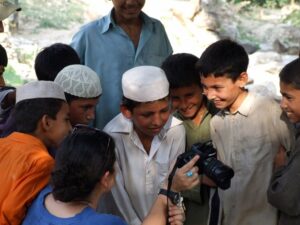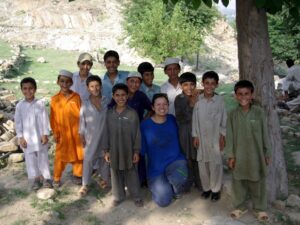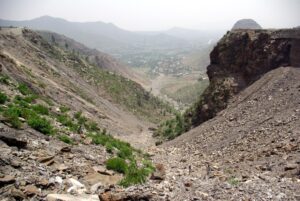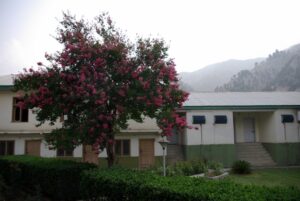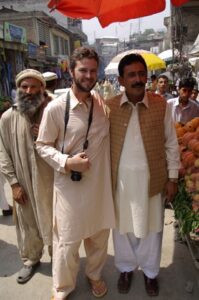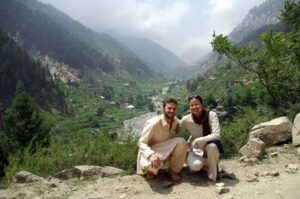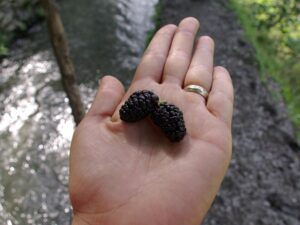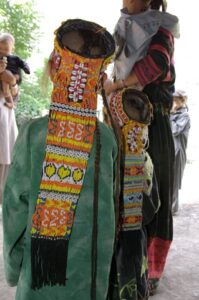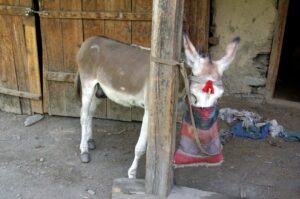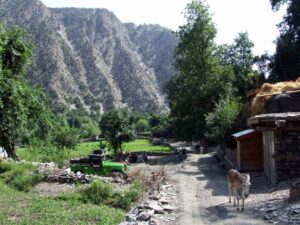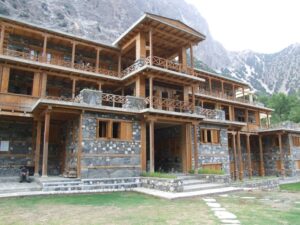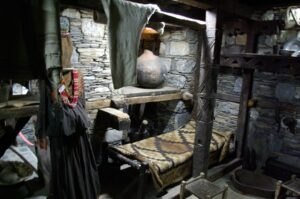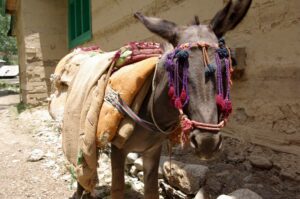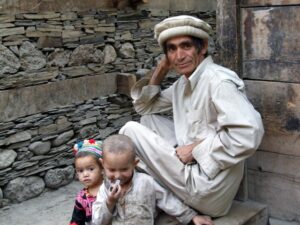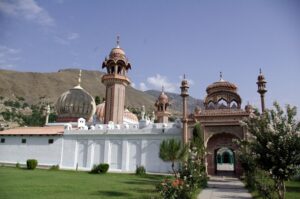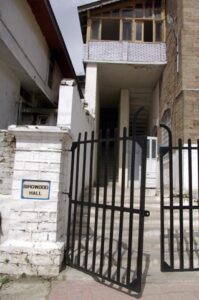Lonely Planet’s introduction of the North-West Frontier Province (NWFP) describes it as “stretching for 700 km along the border of Afghanistan, astride the Khyber Pass and other historical gateways that led to India from Persia and Central Asia, and embracing some of Asia’s most impenetrable mountains and intractable peoples…a large part of NWFP’s attraction lies in its mysteriousness, all the things visitors can’t see or fathom – tribal life, border areas, remote Kohistan, the secret traditions of the Kalasha valleys.” Our route through the NWFP took us from Islamabad to Mardan, the Malakand Pass, Dir, Kalasha Valleys, and Chitral.
4 July 2008: Our Emirates flight from Dubai to Islamabad landed on time at 0830. Once we hit the ground, there was massive confusion as to which time zone we would actually be honoring. A few weeks ago, in an effort to save electricity, Pakistan’s government decided to adopt Daylight Savings. Therefore, the government decided that at the stroke of midnight between 31 May and 1 June, all clocks would be advanced by an hour. The end result was not pretty…we soon found out that many areas openly disdain Daylight Savings. As a result, we heard everyone referring to the time as either “old time” or “new time”. Northern areas generally didn’t adopt the new time, and the Emirates staff further compounded our confusion by telling all passengers to set their watches to the old time. Needless to say, we were all screwed up as to what time it was during our first couple of days in Pakistan!
Our dear friend Saeed was waiting patiently for us at the Islamabad International airport. We were quite happy to see him, and he quickly led us away from the hustle and bustle of the arrivals section to our awaiting driver, Hamid, and 4×4 jeep. After loading up our luggage, we set off on a long drive towards the Malakand Pass and onward to Dir. First we had to navigate our way through Islamabad/Rawalpindi, where we kept getting stopped by police who weren’t used to seeing a jeep in the downtown areas. Saeed explained that Jeeps are a common mode of transportation up North, but are not frequently seen in the Islamabad area. The police decided to take this opportunity to stop us, find fault with the vehicle (in this case one of the 2 license plates was partially cracked), and demand a bribe in order to allow us to pass through. Extorting Saeed is an impossible task, so out of sheer frustration, a police officer approached us directly and demanded we hand over our passports. Both times, Robby feigned ignorance, and pretended not to understand. We didn’t see the correlation between our jeep being detained with relinquishing our passports to an arrogant policeman. Robby did take advantage of our brief roadside break to hop over to a nearby ATM to get some rupees for the duration of our trip.
Once the police bribe issue was sorted out (Saeed kept arguing intensely against paying it and was quite adamant in his refusal), we were dismissed with a hand wave of the police and sent on our way. We were quite happy to be on the road escaping the stifling hot weather of Islamabad. No wonder that many Pakistanis who live in Central or Southern Pakistan flee to the cooler climes of the Northern Areas for some relief. We only experienced the weather in Islamabad for a few hours but it was more than enough for us! Hamid drove us on the M1 towards Peshawar and at Mardan (the spot where Robby drove us to Takht I’Bhai on our first Pakistan adventure), we veered up North towards Malakand. This portion of the drive was awesome partly because we got hours of entertainment from a nearby river that skirts the road the entire way. We saw numerous children (and some adults) jumping into the river for some summer fun to cool off, bathing, and washing laundry.
We drove on Malakand Pass (there had been some fighting here recently but a tour group successfully passed this route approximately 2 weeks ago and the road was still deemed safe), and had to make frequent stops to register our passport and visa information at the “Foreigner Checkpoints” that we passed along the way. We stopped for lunch at a Bat Khela restaurant. The restaurant was owned and run by an Afghan family who lived near Jalalabad but had fled to Pakistan to start a new life. The food here was excellent, and we enjoyed our traditional Afghan style lunch. Afterwards, we paid a visit to Saeed’s friend (Sadik who works in Saudi Arabia) and were invited into his home for some drinks and snacks and conversation. His home was very close to the rarely visited 1st Century AD Buddhist ruins of Chatpat. We could have walked the slight incline uphill to get to the Buddhist ruins, but Hamid insisted on loading us all into the jeep for a short (but super bumpy) ride uphill. We were quickly swarmed by the boys of Chakdarra who had chased our jeep the entire route uphill in plastic flip flops. We soon found out the boys were photo hounds, and they posed happily for photo after photo with us. The Chatpat Ruins reminded us a lot of Takht Bhai, and the views surrounding this serene site were quite lovely. Sadik told us that the Buddhist relics had been moved to the nearby Chakdara Museum for safekeeping. We wanted to pay a short visit to the museum, but on our way back down Robby got sucked into an impromptu cricket match with the boys. Unfortunately for us, the Chakdara Museum was closed due to Friday prayers, so we decided to bid our new found friends of Chakdara goodbye. Sadik and his family kept insisting that we spend the night at his house, but we still had a long drive ahead of us to reach Dir, so we pressed onwards.
Earlier in the day, we had noticed that our jeep was making a loud clanking noise at random internals. While in Chakdara, we tried to find a replacement part (but again, all the stores were closed due to it being a Friday), so we decided to make do and hobble into Dir where we were sure to find a mechanic who could fix the problem. We finally crawled into Dir at 2100 and arrived to darkness at the Dir Hotel. The generator kicked on a few minutes later, and we stayed in the Kumrat House room, which we were told was the room that the nawab of Dir used as his personal suite. Saeed presented us with gifts of three outfits of tailor made shalwar kameez which we immediately wanted to try on. First, we had to take cold water showers (which were quite welcome after a sweltering, hot day), and afterwards, enjoyed a later dinner with Saeed and Hamid at 2200. Immediately afterwards, neither one of us had problems falling promptly asleep.
5 July: Our itinerary for today was to make our way from Dir to Kalash Valley for an overnight homestay. We inadvertently overslept due to the time change confusion, and showed up at our agreed upon 0800 breakfast meeting, not realizing that it was actually already 0900. Saeed had left us a post-it explaining that he was at the bazaar with Hamid attempting to get our jeep fixed, so we settled for breakfast on our own. Afterwards, we ran into Saeed when we decided to walk around Dir’s bazaar for a quick look around. We found the locals to be very friendly, curious, and welcoming. Becky noticed the lack of women at the bazaar as it was full of young boys and men, but not a single woman! Dir’s bazaar was lively and colorful, and we caused a commotion with the locals wanting to take photos with us. It is hard to imagine that this area of Pakistan is advised as “off limits” due to terrorism.
By midday, we were still in Dir waiting on Hamid to return with our jeep and Saeed got a call from VE headquarters asking about the delay. We were relieved to hear that if there was a major malfunction with the jeep, the company had given the “go ahead” to get another mode of transport so that our tour wouldn’t be delayed any further. Shortly afterwards, Hamid showed up and we zoomed off towards Kalash. Unfortunately, we quickly noticed that the jeep was still having mechanical problems as the loud clanking reappeared about an hour into our drive. Nothing we could do at this point, so we hoped for the best and drove on.
We had a brief stop at the lovely Naghar Fort, a scenic fort-cum-guesthouse overlooking a bend on the Chitral River, which used to house and still belongs to the former rulers of Chitral. We met the ever friendly Prince Faisal (and later on met his brother Prince Ghazi), the two sons of Prince Salahuddin. After sharing a cup of tea with Prince Faisal and reading through the visitor’s log book, we were highly tempted to sleep over at the prince’s request. However, we still had several hours drive to reach Kalash so we regrettably declined.
Just before dusk, we finally reached our destination, the Kalasha Valleys. These three narrow, rather isolated valleys of the HindoKush range include Birir, Bumboret, and Rumbur. Living in these valleys is the Kalasha tribe, which numbers from 2,500 to 3,000 members. The Kalasha are non-Muslims believed to be descendants of Alexander the Great’s army. Tonight, we decided to sleep in Birir Valley at the Insaf Hotel but it was already booked, so we agreed to a homestay at the Kalash Guest House instead. Our simple, bare-bones room was adjacent to our Kalash host’s own home. We still had a few minutes of lingering daylight so we walked uphill to admire the final rays of the sun set before returning back to our guesthouse for a delicious vegetarian dinner. Saeed supplemented our dinner with several sumptuously sweet mangoes we bought at the Dir bazaar, and we went to bed stuffed. Surprisingly, we had electricity, and were grateful that we didn’t have to stumble to the outhouse in the dark. After laying down our sleeping mats and bags on the carpeted ground, we both fell fast asleep. Saeed and Hamid decided to camp out on the roof of our host’s home, which was a good plan (nice cool breeze) until 0400 the next morning when a torrential downpour rudely woke them up.
6 July: A brisk shower in the outhouse was enough to invigorate us for the day. We decided to do a quick hike around Birir Valley while our host prepared breakfast. We didn’t realize that “a quick hike” would entail walking up to the irrigation canal high above the valley, following it until we got to the outskirts of the valley, a stumble and an invitation into a Kalash family’s dwelling, a photo shoot with the friendly Kalash family, a mulberry picking session beneath an overripe mulberry tree, and a return trek back into the valley and across the wooden footbridge to the village. Breakfast consisted of dood chai (mixed milk tea), naan (traditional clay oven bread), and an omelet. Since the Kalash normally do not eat chicken or eggs, we were surprised to see that they had prepared us an omelet. After breakfast, we took some photos with our gracious hosts and promised to send them some copies once we got back home.
Hamid was standing by our jeep with a bunch of Birir valley kids clamoring for a group photo. We happily obliged before waving goodbye. Next stop was Bumboret Valley, which Lonely Planet claims as the “most picturesque valley”. Ummm, we have to respectfully disagree. For us, it was way too touristy with far too many hotels, and it felt like Bumboret lost the natural charm that Birir held. Hamid drove us all the way to the end of the valley where we disembarked next to a mosque. Although the Kalasha are non-Muslim, they are constantly bombarded with immigrants from neighboring Afghanistan and elsewhere in Pakistan pressuring them to embrace Islam, and many Kalasha have converted. Hence the mosque calling all Muslim faithful to prayer when we arrived to Bumboret. Saeed introduced us to several of his Kalasha female friends who he had befriended over the years at the various festivals. All of them participate in the traditional dancing that occurs at annual Kalasha festivals, and they were very happy to share their heritage with us. Becky was soon dressed from head to toe in a traditional female Kalasha outfit and led to the village square in Bumboret where the festival dances take place…very cool! We also drank copious amounts of some home made wine which was super strong (and tasty).
A brief visit to the Kalasha Museum in Bumboret was a highlight. We met the super friendly Greek curator who explained that the Greek government sponsored the building of the cultural center of Kalasha or “Kalashadur” to capture the history of the Kalasha tribe, which she adamantly believed to be descendants of Alexander the Great’s troops. The artifacts and photographs in the museum were laid out in a very easy to follow manner, and we definitely recommend that visitors to the Kalasha Valleys pay a visit to this fine museum. Our last visit of the day was a stop to Rumbur Valley where we decided to stay overnight at the excellent Ingineer Khan’s Kalash Home guesthouse. We were invited to relax with a cup of tea and a plateful of fresh apricots, but were keen to hike around Rumbur with the limited daylight remaining so we decided to press on and return for dinner and chai later. Rumbur is perhaps our favorite Kalash Valley as a nice compromise between Bumboret and Birir. It is an extremely serene, peaceful and beautiful corner of Pakistan, and we really enjoyed our time here. The Kalasha were very friendly, and as Robby and Saeed hiked upward to a male-only Kalasha sacred altar, Becky found herself surrounded by several curious Kalasha girls. We spent some time getting to know the children and were invited to visit the rest of their family at their nearby home. We really enjoyed this cultural interaction, and can only imagine how much longer the Kalash will be able to preserve their unique traditions and lifestyle. A short hike through Rumbur Valley was the highlight of our day, and we easily could have stayed here for several days instead of just one night! Later on we read in Ingineer Khan’s guesthouse visitor’s log and saw that many other travelers came to the same conclusion, with most of them extending their stay here.
Saeed got some bad news upon our return to our guesthouse, and was beckoned back to Islamabad due to a family emergency. Vertical Explorers (VE) had send us another tour guide in his stead, Zia Ali, but we didn’t really have much time to comprehend the sudden change because Saeed was off in a hurry and we were confused if he was going to be able to join us later in the tour or if Zia was our new guide…we were saddened because Saeed had been in contact with us ever since our last trip to Pakistan and had helped us develop every stage of this tour. And we were worried about his family emergency, and prayed that it wasn’t too serious. As it turned out, we didn’t end up seeing Saeed again until our last day in Pakistan, and Zia accompanied us throughout the duration of our trip. Poor Zia had just come from a Kashmir domestic tour and had traveled all night to bring Saeed the devastating news of his family (we were out of cellular phone coverage in the valleys). Needless to say, Zia was exhausted after all his non-stop travel, but we were glad that VE had handled the situation as professionally as they possibly could.
Over dinner at Ingineer Khan’s, we met and befriended a crazy 21 year old Scotsman named Craig, who had traveled around the world several times. We were quite impressed at how he had been able to stretch his budget so carefully and he wowed us with tales of his adventures in China, Vietnam, and India. Craig caught wind that we were headed to the Shandur Festival tomorrow and asked if he could hitchhike a ride with us. We agreed and set an early morning departure as we had a long drive ahead of us from Rumbur to Shandur via Chitral.
7 July: Even the best laid plans sometimes go to the wayside. We had coordinated with Zia for a 0530 breakfast, 0600 departure but not a creature was stirring at 0530. At 0630 Zia apologized for oversleeping but we wondered if he had told Ingineer of our plans for an early morning breakfast? In any case, we ate some yummy paratha (thick, layered bread), topped with marmalade and butter, and downed it with a couple cups of chai. Delicious! After thanking Ingineer Khan and his wife for their hospitality, we picked up Craig (our Scottish hitchhiker), loaded up the jeep, and head off towards Shandur. First, we had a brief stop in Chitral to visit the Chitral Fort. Lonely Planet states “the mehtars’ palace-fortress is still occupied by descendants of the royal family…the most interesting side faces the river”. We didn’t have any problems sneaking a peak of the inside grounds of the fort, and afterwards, paid a brief visit to the adjacent Shahi Masjid (Grand Mosque).
(7 – 26 July spend visiting other sections of Pakistan.)
27 July 2008: Jan had already warned us we had another long day ahead of us today. The drive from Besham to Islamabad would take the majority of the day, and we were going to try to squeeze in a visit to Murree, a series of colonial hill stations developed by the British as a summer retreat from the heat of Islamabad. Besham marked the end of the KKH, but the route we took back towards Islamabad was equally as fascinating. Goat and sheep markets sprung up in some towns, colorful fruit markets caught our attention, and we quickly noticed the temperature rising as we headed south. Just before lunch, we stopped at Abbottabad for some delicious fresh mango and banana juice…what a nice treat!
The group took a consensus and decided to detour to Murree, located about 70 km away. Zia assured us this route, taken up through the hills, would be a cooler drive than going straight down towards Taxilla and then onward to Islamabad. We were completely flexible, and were surprised to see the carnival like atmosphere in the hill towns around Murree. It was a Sunday, and it seemed that a majority of Islamabad’s residents had joined us here for a short weekend getaway. The roads were packed, meats were grilling, families were all out in full force having a merry old time. We really liked the vibe here, and strolled around Murree’s “The Mall” pedestrian street, seeking our own fun. More mango juice ensued, followed by some tasty fried snacks, and window shopping. The women here appeared a lot more laid back and relaxed about wearing the head scarf, and the scene here was reminiscent of any other holiday town. Everyone was out to have a good time. Robby decided to shoot a bunch of balloons with a pellet gun, and had to laugh when the vendor decided to bump up the price afterwards. Some of the locals joined in to haggle the price down, saying it wasn’t right for the vendor to try to take advantage of tourists…the price was compromised down to a reasonable level and we escaped Murree with a hitchhiker, Ishaq, who runs a digital media studio in Rawalpindi.
The drive back to Islamabad flew by, and before we knew it, we had dropped Ishaq off near his home (he had invited us for dinner but we declined as we had other plans). We were pleasantly surprised when we were greeted by the Vertical Explorer staff that had come out to meet us in the parking lot of our hotel, Hotel Usmania at Committee Chowk, Rawalpindi. Saeed was there! Yeah…we were sooooo happy to see him again and thrilled that he surprised us with a visit. Another surprise was in store for us and Hamid was also in Rawalpindi awaiting our arrival. Thus, we had all 4 of our guides/drivers all at one place…it felt like a family reunion. We were so excited to see everyone and quickly checked into our room so we could get caught up. We talked on and on, and finally had to take a break for dinner. Saeed was going to accompany us to the restaurant of our choice (Chinese of course!) and Jan, Hamid, and Zia were going to return back to the Vertical Explorer’s apartment and crash for the night. We agreed to link up with them again tomorrow for our ride to the airport (more clientele was arriving so it was great timing wise). The Mei Kong restaurant in Rawalpindi was an excellent choice, and our dinner was absolutely sumptuous. We were so craving good Asian food, but we were stuffed after our massive bowls of tum yum soup. We made every effort to eat the rest of our dinner and left the Mei Kong extremely satisfied. After bidding Saeed a good night’s sleep, we both fell promptly asleep, with the anticipation of getting up early to pack for our onward trip to Dubai tomorrow.
28 July: It was a short drive from Hotel Usmania to the Islamabad International airport, but the whole gang showed up early and in full force to ensure that we had plenty of time to catch our Emirates flight. Parking at the airport was the trickiest part…we had to find enough room for a jeep and an SUV and the parking lot was packed. Eventually, we managed to find two parking spots, and immediately it hit us that this was it…the final goodbye. We hate goodbyes so instead we said “until next time”. Saeed had already filled our imagination with more sights to see in Southern Pakistan, so a return trip with him as our guide is definitely in order! We thanked Saeed, Zia, Hamid and Jan for the adventure of a lifetime before waving our final goodbyes in the check in line. The past three weeks had been a non stop whirlwind of sights and sounds, and we will never forget our summer excursion into one of the world’s prettiest destinations. Pakistan is a country that invades your soul…now that we’ve been, we can’t wait to go back!
